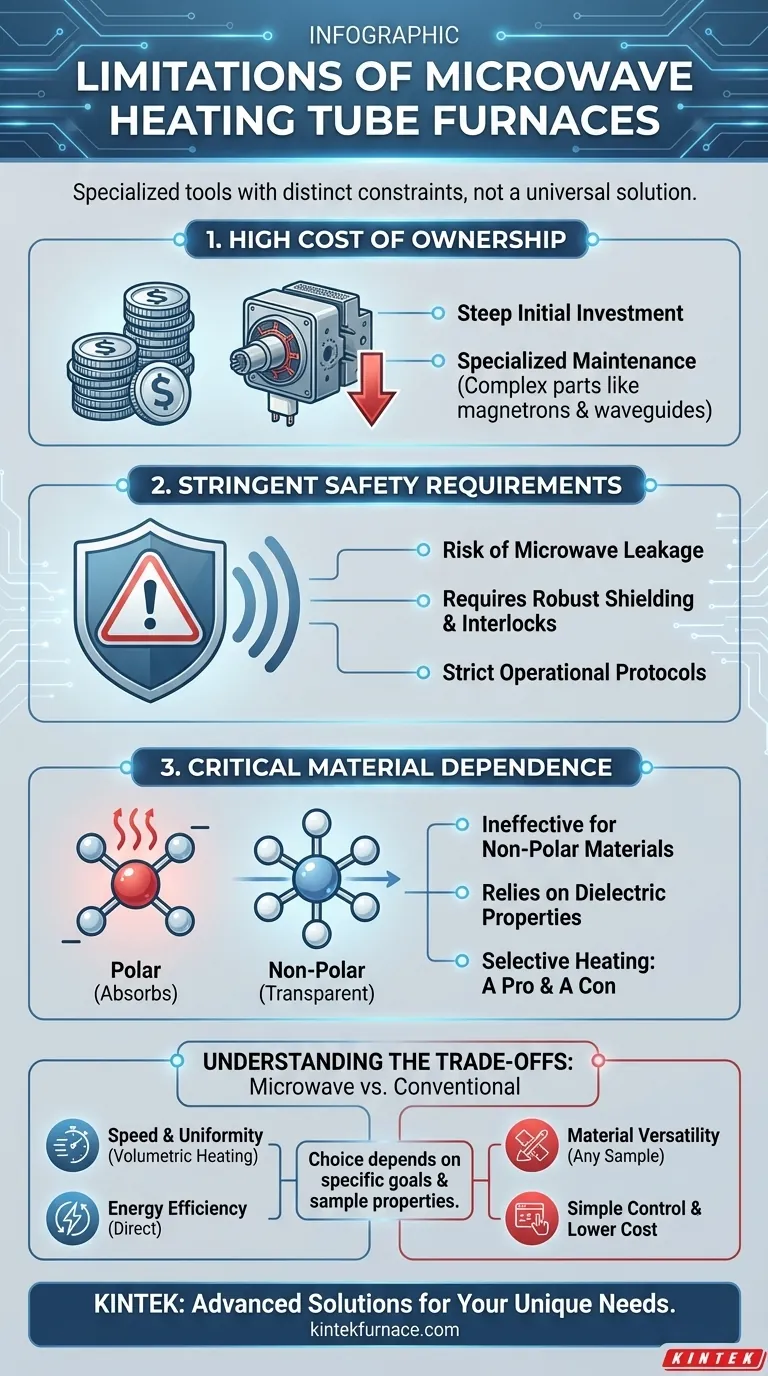The primary limitations of microwave heating tube furnaces are their high cost, stringent safety requirements, and critical dependence on the material being processed. These factors make them a specialized tool rather than a universally applicable heating solution. Unlike conventional furnaces, their effectiveness is not guaranteed for all sample types, particularly those with poor microwave absorption properties.
While offering unmatched speed and selective heating, a microwave tube furnace's utility is fundamentally constrained by its high cost of ownership and its inability to effectively heat non-polar materials, requiring careful evaluation of both your budget and your sample's specific properties.
The Core Challenge: Material-Microwave Interaction
The most significant limitation of a microwave furnace is not its hardware, but the physics of how microwaves interact with matter. Its performance is entirely dependent on the sample's inherent properties.
The Problem of Non-Polar Materials
A material's ability to be heated by microwaves is determined by its dielectric properties. Substances with polar molecules (like water) absorb microwave energy efficiently and heat up rapidly.
Conversely, non-polar substances are largely transparent to microwaves. They do not absorb this energy and will not heat effectively, if at all. This makes microwave furnaces unsuitable for certain applications, such as the pyrolysis of specific polymers or other non-polar organic feedstocks.
The Paradox of Selective Heating
This limitation is also one of the furnace's most unique advantages. In a mixed-material sample, microwaves can selectively heat only the components that absorb microwave energy.
While this is a powerful tool for advanced material synthesis and catalysis, it becomes a critical failure point if the component you need to heat is non-absorbent.
High Cost of Ownership
Microwave tube furnaces represent a significant financial commitment that extends beyond the initial purchase.
Steep Initial Investment
The technology is inherently complex. Components like the magnetron (microwave generator), waveguides, and specialized resonant cavities are costly to manufacture with precision. This results in a much higher equipment cost compared to conventional resistance-heated tube furnaces.
Specialized Maintenance
These are not simple systems with replaceable heating elements. Repairing and maintaining the microwave generation and delivery system requires specialized technicians and expensive parts, leading to a higher total cost of ownership over the furnace's lifetime.
Understanding the Trade-offs
Choosing a microwave furnace means accepting its limitations in exchange for distinct performance advantages not found in other systems.
Speed and Uniformity vs. Versatility
A key benefit of microwave heating is its volumetric nature. It heats the entire volume of a suitable sample simultaneously, from the inside out. This is extremely fast and eliminates the temperature gradients common in conventional furnaces, which heat from the outside in.
However, a conventional furnace using a quartz or alumina tube offers far greater material versatility, reliably heating almost any sample regardless of its dielectric properties, albeit more slowly.
Direct Energy Application vs. Safety Overhead
Microwave furnaces can be highly energy-efficient because the energy is delivered directly to the sample. Less energy is wasted heating the furnace chamber, insulation, and support fixtures, a major issue in traditional batch furnaces.
This efficiency comes at the cost of safety. The risk of microwave leakage, which is hazardous to operators, necessitates robust shielding, safety interlocks, and strict operational protocols that are not a concern with resistance or induction heating.
Complex Physics vs. Simple Control
While modern interfaces simplify operation, effectively using a microwave furnace requires an understanding of microwave physics. In contrast, a conventional furnace operates on a simple principle: set a temperature, and the furnace heats to it. This makes training and operation fundamentally more straightforward.
Making the Right Choice for Your Application
Your decision must be guided by your specific experimental or production goals, as no single furnace type is superior in all contexts.
- If your primary focus is rapid, uniform heating of a known, microwave-absorbent material: A microwave furnace is a powerful and efficient option worth the investment.
- If your primary focus is versatility for processing a wide variety of materials: A conventional resistance-heated tube furnace offers a more reliable and budget-friendly solution.
- If your primary focus is process safety and operational simplicity: A conventional furnace presents a lower learning curve and fewer specialized hazards.
Ultimately, choosing the right furnace requires matching the technology's specific strengths and weaknesses to your core mission.
Summary Table:
| Limitation | Key Details |
|---|---|
| Material Dependence | Ineffective for non-polar materials; requires specific dielectric properties for heating. |
| High Cost | Steep initial investment and specialized maintenance increase total ownership cost. |
| Safety Requirements | Risk of microwave leakage necessitates robust shielding and strict protocols. |
| Operational Complexity | Requires understanding of microwave physics, unlike simpler conventional furnaces. |
Struggling with heating inefficiencies or high costs in your lab? KINTEK specializes in advanced high-temperature furnace solutions tailored to your unique needs. Leveraging exceptional R&D and in-house manufacturing, we offer products like Muffle, Tube, Rotary Furnaces, Vacuum & Atmosphere Furnaces, and CVD/PECVD Systems, with strong deep customization capabilities to overcome limitations and enhance your experimental outcomes. Contact us today to discuss how our solutions can optimize your processes and deliver reliable performance!
Visual Guide

Related Products
- 1700℃ High Temperature Laboratory Tube Furnace with Quartz or Alumina Tube
- 1400℃ High Temperature Laboratory Tube Furnace with Quartz and Alumina Tube
- High Temperature Muffle Oven Furnace for Laboratory Debinding and Pre Sintering
- Split Multi Heating Zone Rotary Tube Furnace Rotating Tube Furnace
- Laboratory Muffle Oven Furnace with Bottom Lifting
People Also Ask
- How do tube furnaces work? Achieve Precise Thermal Processing for Your Materials
- How to clean a tube furnace? A Step-by-Step Guide to Safe and Effective Maintenance
- What safety measures are essential when operating a lab tube furnace? A Guide to Preventing Accidents
- What recent improvements have been made to lab tube furnaces? Unlock Precision, Automation & Safety
- How to operate a tubular furnace? A 5-Phase Guide for Safe and Repeatable Results



















